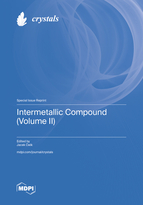Intermetallic Compound (Volume II)
A special issue of Crystals (ISSN 2073-4352). This special issue belongs to the section "Crystalline Metals and Alloys".
Deadline for manuscript submissions: closed (31 July 2023) | Viewed by 24938
Special Issue Editor
Interests: fabrication of intermetallic compounds with specific magnetic properties via the arc melting method; measurements of magnetic properties; measurements and study of the magnetization; magnetocrystalline anisotropy; magnetocaloric effect of intermetallic compounds
Special Issues, Collections and Topics in MDPI journals
Special Issue Information
Dear Colleagues,
In modern society, the applications of new functional materials are diverse and countless. Intermetallics, namely, compounds formed by two or more metallic elements, are among the various novel and significant materials developments. Intermetallics have received considerable attention owing to their potential for various applications, such as permanent magnets, magneto-optical recording media, hydrogen storage and magnetocaloric materials, turbine blades, and in microelectronics. With a favorable combination of high strength, low density, and good corrosion resistance, intermetallics are specifically suited for applications at high temperatures and in adverse environments. They can also display desirable magnetic, superconducting, and chemical properties due to their strong internal order and mixed metallic and covalent or ionic bonding, respectively.
We invite researchers to contribute to this Special Issue on “Intermetallic Compound (Volume II)”, which is intended to serve as a unique multidisciplinary forum covering broad aspects of the science, technology, and application of intermetallic compounds.
Potential topics include but are not limited to:
- Synthesis of intermetallic compounds;
- Characteristics of structural properties;
- Type of intermetallic compounds;
- Unique properties;
- Applications.
Dr. Jacek Ćwik
Guest Editor
Manuscript Submission Information
Manuscripts should be submitted online at www.mdpi.com by registering and logging in to this website. Once you are registered, click here to go to the submission form. Manuscripts can be submitted until the deadline. All submissions that pass pre-check are peer-reviewed. Accepted papers will be published continuously in the journal (as soon as accepted) and will be listed together on the special issue website. Research articles, review articles as well as short communications are invited. For planned papers, a title and short abstract (about 100 words) can be sent to the Editorial Office for announcement on this website.
Submitted manuscripts should not have been published previously, nor be under consideration for publication elsewhere (except conference proceedings papers). All manuscripts are thoroughly refereed through a single-blind peer-review process. A guide for authors and other relevant information for submission of manuscripts is available on the Instructions for Authors page. Crystals is an international peer-reviewed open access monthly journal published by MDPI.
Please visit the Instructions for Authors page before submitting a manuscript. The Article Processing Charge (APC) for publication in this open access journal is 2600 CHF (Swiss Francs). Submitted papers should be well formatted and use good English. Authors may use MDPI's English editing service prior to publication or during author revisions.
Keywords
- Functional alloys
- High-entropy alloys
- Shape–memory alloys
- Magnetic properties
- Thermal properties
- Thermodynamic properties
- Grain boundary
- Superconducting






